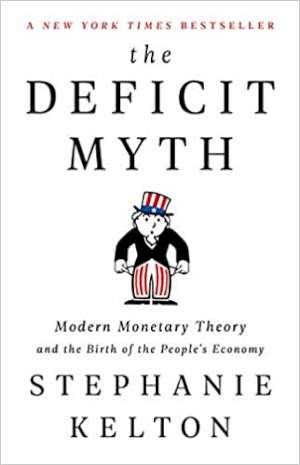23 July 2020
The Deficit Myth:
Modern Monetary Theory and the Birth of the People’s Economy
Stephanie Kelton
2020, PublicAffairs,
ISBN 9781541736184
Reviewer: Melissa Davies

The Deficit Myth, by Stephanie Kelton, is a wonderful introduction to the ‘through-the-looking-glass’ economics of Modern Monetary Theory – the increasingly fashionable challenger to the orthodox thinking that has dominated macro policy-making since the taming of the Great Inflation. Professor Kelton is well-placed to bring this theory into the mainstream with this easily accessible book, being a key player in the current MMT ‘scene’ and former Chief Economist of the US Senate Budget Committee. Published on the eve of the COVID-19 crisis, the recommendations of the book predate the extraordinary circumstances we find ourselves in, but they could not be more relevant.
At its heart, MMT argues in favour of a handful of ‘descriptive’ claims about the way government financing actually works. Some find these claims to be complete common sense and others heretical anathema. Regardless of how one feels about MMT-style arguments, they are become increasingly high-profile in US policy circles and are being closely followed by financial market participants. If correct, they point to a completely different direction for macro policy in the recovery from the COVID-19 crisis than orthodox economics would suggest.
The core claims of MMT include the argument that governments do not need to raise taxes or issue bonds to spend money. Instead they create their own financing – taxes and bond issues are liquidity draining, not financing, measures. Government can always control their cost of financing. Government deficits create private sector savings, rather than deplete them. Money and government bonds are simply interchangeable state liabilities – ‘green’ and ‘yellow’ dollars, in Kelton’s terminology. In this world, sovereign currency issuers are not constrained by the size of their deficits, only by the underlying resource capacity of the economy to expand without generating runaway inflation.
The ‘prescriptive’ element of MMT is what the government should do to create employment. Kelton argues in favour of a US Public Service Employment programme which would guarantee a $15 an hour wage and provide a safety valve for workers in difficult economic times. Such a scheme would have provided a powerful parachute for economies in 2020.
Kelton makes an impassioned argument in favour of the state fully using its money-creating powers to address the infrastructure, health, education and environmental deficits in the US economy. MMT creates a powerful moral case for government to do more with its currency-printing powers which is only magnified by the current crisis.
The sheer scale of the COVID-19 shock, in health, social and economic terms, may mean there is little choice but to head further down the road to MMT.
But this theory may raise more questions than it answers – having persuasively made the case for how the economy can be set free from the constraints of balanced budget government thinking, it is not clear whether the jobs guarantee sheds sufficient light on how policy could be managed in a world of such freedom.
Replacing household-style budgeting with an inflation-unemployment target for the entire complex of fiscal and monetary policy, perhaps rightly, opens up a huge can of worms as to how taxation, debt management and central bank balance sheets might function. Especially in the current environment, where inflationary pressures are notable by their absence, how can government prioritise what and where to spend, if resources are unlimited? With what do we actually replace the old world of independent central banks and constrained government budgets?
That we are even asking these questions is, perhaps, a mark of MMT’s success. It has moved firmly from a fringe theory to one that may strongly influence real policy-making in the post-COVID-19 world of huge government deficits, minimal borrowing costs and double-digit unemployment. It may be an idea whose time has come – there may simply be no alternative.
